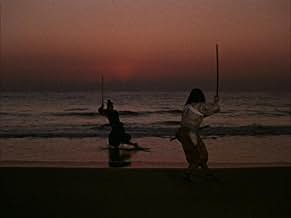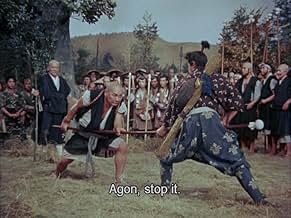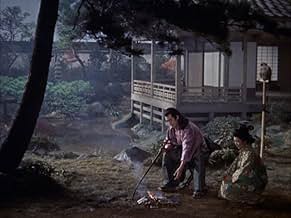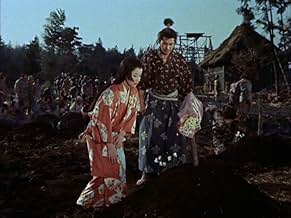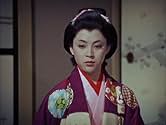VALUTAZIONE IMDb
7,5/10
6998
LA TUA VALUTAZIONE
Aggiungi una trama nella tua linguaMusashi Miyamoto is challenged to a duel by a confident swordsman Sasaki Kojiro. He agrees to fight him in a year's time.Musashi Miyamoto is challenged to a duel by a confident swordsman Sasaki Kojiro. He agrees to fight him in a year's time.Musashi Miyamoto is challenged to a duel by a confident swordsman Sasaki Kojiro. He agrees to fight him in a year's time.
- Regia
- Sceneggiatura
- Star
Recensioni in evidenza
This was, by far the best of the trilogy and a fine ending. It had less Samurai action that the other two, but it was much more inspiring.
Kojiro (Koji Tsuruta) thought himself the best in the land and sought a duel with Musashi (Toshirô Mifune). But Musashi wanted to devote his life to becoming a better person. he went back to the land that he rejected and became a farmer.
In the meantime, both Otsu (Kaoru Yachigusa) and Akemi (Mariko Okada) managed to find him. Can you imagine that scene? Feeling rejected, Akemi is made to betray Musashi to the brigands. The effort fails and Musashi accepts the duel with Kojiro.
The duel itself was magnificent but short. It was a fitting end to a film that featured outstanding cinematography and a compelling story of the drive to perfection.
Kojiro (Koji Tsuruta) thought himself the best in the land and sought a duel with Musashi (Toshirô Mifune). But Musashi wanted to devote his life to becoming a better person. he went back to the land that he rejected and became a farmer.
In the meantime, both Otsu (Kaoru Yachigusa) and Akemi (Mariko Okada) managed to find him. Can you imagine that scene? Feeling rejected, Akemi is made to betray Musashi to the brigands. The effort fails and Musashi accepts the duel with Kojiro.
The duel itself was magnificent but short. It was a fitting end to a film that featured outstanding cinematography and a compelling story of the drive to perfection.
This film is the final installment of director Hiroshi Inagaki's "Samurai Trilogy," three films covering the life of Musashi Miyamoto (Takezo,) Japan's most famous swordsman of the early 17th century and perhaps of all time.
He was an icon of the warrior-philosopher model. He survived numerous duels to the death and retired to painting and writing. His best known work is the "Book of Five Rings," a book which gained popularity recently when it was championed by the Harvard Business School.
All three films of Inagaki's trilogy, made in 1954, 1955, and 1956, are part of the elite Criterion Collection of classic films.
Briefly, this movie resolves the conflict of the two women in Takezo's life, Otsu and Akemi, and leads up to Musashi's showdown with the second most famous swordsman of the day, Sasaki Kojiro. This is the famous Duel at Ganryu Island of the title.
Although I cannot appreciate the Japanese language and must rely on the English subtitles for the meaning of dialog, I do appreciate the beauty of this early widescreen color film. (I believe Tojoscope is a Japanese version of cinemascope.) One could take almost every frame of this film and it would make a stunning still. The costumes and the sets reflect an attention to detail of color, lighting and composition.
For its sense of rather understated action, I particularly enjoyed the opening scene. Sasaki Kojiro demonstrates his signature Swallowtail Turn, a move whereby he severs the tail feathers of this notably swift and agile bird in flight. It's not the portrayed animal cruelty that I enjoyed; it's the human quickness and skill that would be required to accomplish such a feat. I certainly hope that no birds were actually harmed in the making of the film.
He was an icon of the warrior-philosopher model. He survived numerous duels to the death and retired to painting and writing. His best known work is the "Book of Five Rings," a book which gained popularity recently when it was championed by the Harvard Business School.
All three films of Inagaki's trilogy, made in 1954, 1955, and 1956, are part of the elite Criterion Collection of classic films.
Briefly, this movie resolves the conflict of the two women in Takezo's life, Otsu and Akemi, and leads up to Musashi's showdown with the second most famous swordsman of the day, Sasaki Kojiro. This is the famous Duel at Ganryu Island of the title.
Although I cannot appreciate the Japanese language and must rely on the English subtitles for the meaning of dialog, I do appreciate the beauty of this early widescreen color film. (I believe Tojoscope is a Japanese version of cinemascope.) One could take almost every frame of this film and it would make a stunning still. The costumes and the sets reflect an attention to detail of color, lighting and composition.
For its sense of rather understated action, I particularly enjoyed the opening scene. Sasaki Kojiro demonstrates his signature Swallowtail Turn, a move whereby he severs the tail feathers of this notably swift and agile bird in flight. It's not the portrayed animal cruelty that I enjoyed; it's the human quickness and skill that would be required to accomplish such a feat. I certainly hope that no birds were actually harmed in the making of the film.
Samurai III boasts far superior color and composition to the first installment. The opener includes a beautiful scene of Kojiro and Akemi by a magnificent waterfall. This sets the stylistically polished tone of the film, a nice attempt to revive our interest in the sometimes-stalling narrative (Will Kojiro fight the indestructible Musashi? Is Otsu going to get her man after spurning his inviting advances?)
In terms of eye candy, this finale gives the most exotic colors (some may complain as "un-Japanese"), the best lighting, and the most skin of Mifune's Musashi! The story continues with the intellectual and spiritual education of Musashi. Even though the final duel is set up to be his moment of self-realisation, it is preceded by a tad-curious sequence of Musashi's farmlife. Very reminiscent of the samurai-villager relationship in Seven Samurai, Musashi becomes their protector against bandits. The result is formulaic but does what the story intends: return Musashi to a life of the earth - a humanist existence preached by his Buddhist education - and to his humble origin.
P.S. Although Miyamoto Musashi/Samurai I is crucial to understanding the rise of our hero, it probably got Best Foreign film for 1955 Academy Awards during the sudden "discovery" of Japanese films starting with Rashomon.
And if you're looking for a female figure with as much spunk as Musashi himself, note the courtesan in Samurai II. Her chastisement of Musashi, that he lacks humanly affection and thinks of women as weaklings, almost makes up for the overall iffy portrayal of "romantic heroines" in the trilogy!
In terms of eye candy, this finale gives the most exotic colors (some may complain as "un-Japanese"), the best lighting, and the most skin of Mifune's Musashi! The story continues with the intellectual and spiritual education of Musashi. Even though the final duel is set up to be his moment of self-realisation, it is preceded by a tad-curious sequence of Musashi's farmlife. Very reminiscent of the samurai-villager relationship in Seven Samurai, Musashi becomes their protector against bandits. The result is formulaic but does what the story intends: return Musashi to a life of the earth - a humanist existence preached by his Buddhist education - and to his humble origin.
P.S. Although Miyamoto Musashi/Samurai I is crucial to understanding the rise of our hero, it probably got Best Foreign film for 1955 Academy Awards during the sudden "discovery" of Japanese films starting with Rashomon.
And if you're looking for a female figure with as much spunk as Musashi himself, note the courtesan in Samurai II. Her chastisement of Musashi, that he lacks humanly affection and thinks of women as weaklings, almost makes up for the overall iffy portrayal of "romantic heroines" in the trilogy!
"In the old days, I used to hate farm work. I was always daydreaming, longing for victory and renown. I could think of nothing else. Now I'm tilling the fields again. Isn't it strange? I'm beginning to learn the value of life."
In this film's opening scene, we see Sasaki Kojiro (Koji Tsuruta) tell his lover (Michiko Saga) that he must fight Miyamoto Musashi for no other reason than the two of them are the best samurai in Japan. They're in a beautiful place with waterfalls streaming down and a rainbow arcing gracefully overhead as he calmly states his purpose, something which immediately begs the question, why? He is in an Eden of sorts, and yet feels compelled to fight an honorable man, unprovoked, to death.
Meanwhile we see the spiritual growth of Musashi (Toshiro Mifune) in the very next scene, when he's willing to humble himself and apologize for an offense the boy who's travelling with him has committed. He consistently makes decisions to avoid battle if at all possible, even if the other guy has it coming to him. We see it here, the first time when Sasaki catches up with him in a cemetery, and when he simply shows an ornery guy his fly catching prowess with his chopsticks to let him draw his own conclusions about continuing to provoke him.
The two of these great samurai (who were indeed real 17th century historical figures) are destined to fight one another, though Musashi puts Kojiro off for year, delaying the inevitable. Does director Hiroshi Inagaki effectively fill in the time it takes to get to the titular battle over the film's 105 minutes? Somewhat. There are bandits who must be fought off, and then there are the love interests. Both Otsu (Kaoru Yachigusa) and Akemi (Mariko Okada) are still carrying a torch for Musashi, and arrive in the rural area where he's taken up the simple life of farming. Personally I thought Akemi's character, the fallen woman who men have "made a plaything of," was muddled and added unnecessary melodrama. I think the film would have been stronger had she not been present, or shown instead fading into the ignominy of prostitution. Regardless, this third and last film in the trilogy suffers from some of the same problems its predecessors did, with the two women throwing themselves at his feet in what started to feel like filler until we got to the final battle (though I did like the resolution for Otsu).
The film is visually quite beautiful, with shots in a cemetery, reflections in the water, and walking past Mt. Fuji coming to mind. The poetry and precision of both lead actors striking samurai poses and movements should also be in that list, and nowhere is it done better than in their final battle, which brought the film full circle back to its beginning. There is something symbolic in this fight taking place out on the beach at sunset as the timeless waves gently roll in, oblivious to the human drama. Musashi recognizes it, and it's why he weeps. He weeps for the pointlessness of it, he weeps for mankind's insatiable urge to dominate or kill when it isn't necessary. His spiritual journey is complete, and he'll go back to Otsu and farming, not looking for trouble as he did so brashly at the beginning of the first film. He's enlightened, but how can we hope for humanity when there will always be another Kojiro?
In this film's opening scene, we see Sasaki Kojiro (Koji Tsuruta) tell his lover (Michiko Saga) that he must fight Miyamoto Musashi for no other reason than the two of them are the best samurai in Japan. They're in a beautiful place with waterfalls streaming down and a rainbow arcing gracefully overhead as he calmly states his purpose, something which immediately begs the question, why? He is in an Eden of sorts, and yet feels compelled to fight an honorable man, unprovoked, to death.
Meanwhile we see the spiritual growth of Musashi (Toshiro Mifune) in the very next scene, when he's willing to humble himself and apologize for an offense the boy who's travelling with him has committed. He consistently makes decisions to avoid battle if at all possible, even if the other guy has it coming to him. We see it here, the first time when Sasaki catches up with him in a cemetery, and when he simply shows an ornery guy his fly catching prowess with his chopsticks to let him draw his own conclusions about continuing to provoke him.
The two of these great samurai (who were indeed real 17th century historical figures) are destined to fight one another, though Musashi puts Kojiro off for year, delaying the inevitable. Does director Hiroshi Inagaki effectively fill in the time it takes to get to the titular battle over the film's 105 minutes? Somewhat. There are bandits who must be fought off, and then there are the love interests. Both Otsu (Kaoru Yachigusa) and Akemi (Mariko Okada) are still carrying a torch for Musashi, and arrive in the rural area where he's taken up the simple life of farming. Personally I thought Akemi's character, the fallen woman who men have "made a plaything of," was muddled and added unnecessary melodrama. I think the film would have been stronger had she not been present, or shown instead fading into the ignominy of prostitution. Regardless, this third and last film in the trilogy suffers from some of the same problems its predecessors did, with the two women throwing themselves at his feet in what started to feel like filler until we got to the final battle (though I did like the resolution for Otsu).
The film is visually quite beautiful, with shots in a cemetery, reflections in the water, and walking past Mt. Fuji coming to mind. The poetry and precision of both lead actors striking samurai poses and movements should also be in that list, and nowhere is it done better than in their final battle, which brought the film full circle back to its beginning. There is something symbolic in this fight taking place out on the beach at sunset as the timeless waves gently roll in, oblivious to the human drama. Musashi recognizes it, and it's why he weeps. He weeps for the pointlessness of it, he weeps for mankind's insatiable urge to dominate or kill when it isn't necessary. His spiritual journey is complete, and he'll go back to Otsu and farming, not looking for trouble as he did so brashly at the beginning of the first film. He's enlightened, but how can we hope for humanity when there will always be another Kojiro?
Samurai III: Duel on Ganryu Island is the closing film of Inagaki's Samurai trilogy, the story of Musashi Miyamoto (Mifune). It is one of the best samurai films on its own and has the advantage of having the characters' history established in the first two films of the trilogy. This film abounds in good characters: Musashi's two disciples, a young boy and a horse trader, who exchange good natured barbs and loyally support Musashi; the two women in Musashi's life, good girl Otsu and bad girl Akemi; the brigand leader and his henchman, who was formerly Akemi's stepfather; and of course, Musashi's nemesis, Kojiro Sasaki, who is outstanding in both this film and Samurai II. Kojiro is actually a more interesting character than Musashi and reminds me of Tatsuya Nakadai's performance in Sword of Doom. The climactic duel on the beach with the rising sun in the background is amazing. Side note: This film has four of Kurosawa's Seven Samurai actors: Mifune, Shimura, Kato and Chiaki. See the whole trilogy.
Lo sapevi?
- QuizThis film is part of the Criterion Collection, spine #16.
- BlooperAs the final duel is fought, the duelists have light on the sides of their bodies away from the sun - Sasaki has light on his back and Miyamoto light on his face.
- Citazioni
Musashi Miyamoto: Brace up, Akemi.
- ConnessioniFeatured in Sayonara Jupitâ (1984)
I più visti
Accedi per valutare e creare un elenco di titoli salvati per ottenere consigli personalizzati
- How long is Samurai III: Duel at Ganryu Island?Powered by Alexa
Dettagli
- Data di uscita
- Paese di origine
- Lingua
- Celebre anche come
- Samurai III: Duel at Ganryu Island
- Luoghi delle riprese
- Azienda produttrice
- Vedi altri crediti dell’azienda su IMDbPro
- Tempo di esecuzione1 ora 45 minuti
- Mix di suoni
- Proporzioni
- 1.37 : 1
Contribuisci a questa pagina
Suggerisci una modifica o aggiungi i contenuti mancanti

Divario superiore
By what name was Miyamoto Musashi kanketsu-hen: Kettô Ganryû-jima (1956) officially released in India in English?
Rispondi



